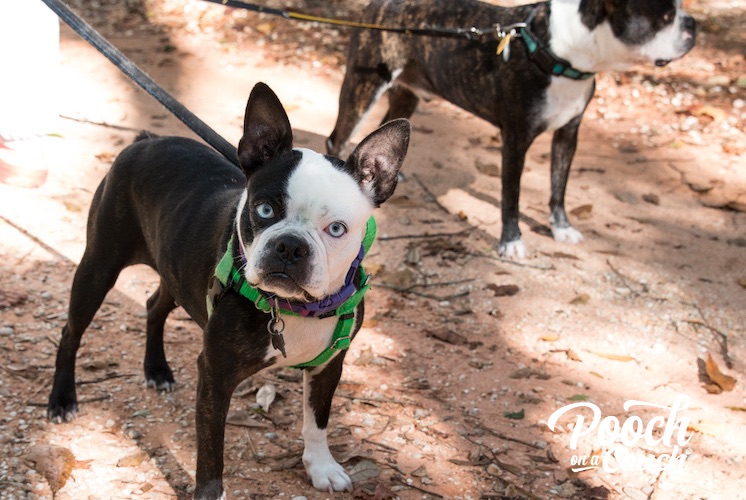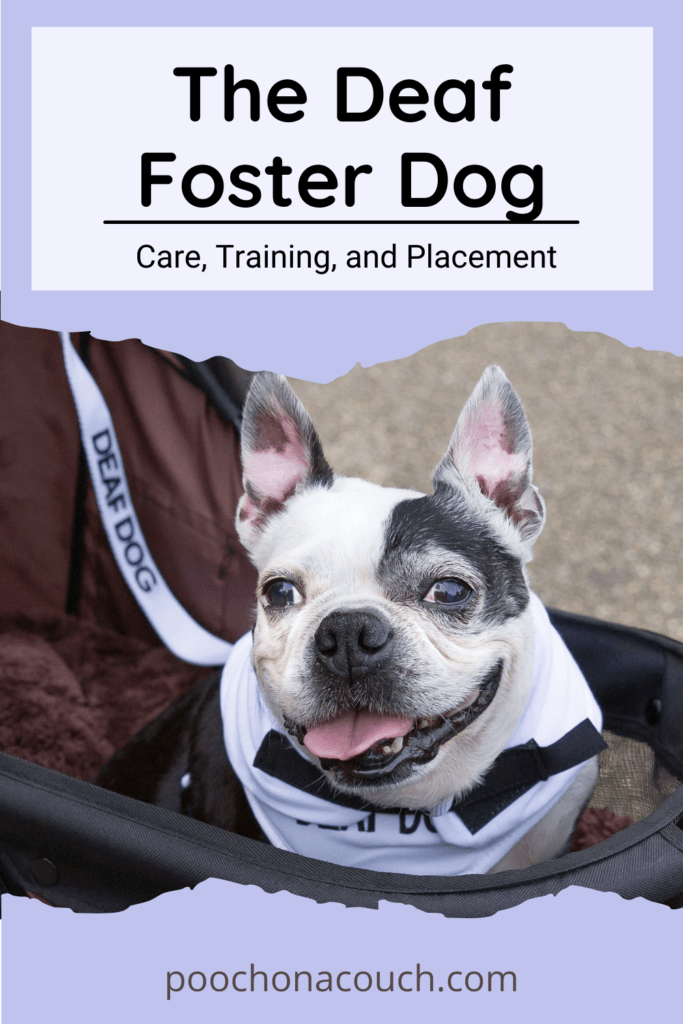According to the AKC, 5-10% of all dogs in the United States have some degree of deafness. Holy cow! I was surprised by that number.
How high are the stats in your rescue agency? How many deaf foster dogs are in your rescue each year? How do you care for a deaf foster dog? Are deaf dogs adoptable? How do you find the right home for a deaf dog?
Disclosure: This post contains affiliate links. As an affiliate, I earn a commission on qualifying purchases made through these links, at no additional cost to you. I only recommend products I use and love or plan to purchase myself.
I foster primarily Boston terriers, a breed with a higher incidence of deafness. In my 12 years of working with a Boston terrier rescue agency, I helped serve many deaf Boston terriers. Some were born deaf and others became deaf, either due to old age or because their ears became too damaged from illness or trauma.
Personally, I’ve fostered 5 deaf Boston terriers.
My first foster dog was an older fella with both vision and hearing loss. My neighbors must have thought I’d lost it – calling out “Loooooo eeeeeee!” as if I were calling pig. But it was all he could hear, and sound helped him navigate the yard.
You can foster deaf dogs! With simple adjustments in how you communicate, fostering a deaf dog is no different than fostering a hearing dog.
I am not a veterinarian nor an animal behaviorist. I present my understanding of health or behavior issues based on personal experience, courses, and readings. If you have a dog with a health or behavioral issue, seek professional guidance. I hope you find my post useful.
What Causes Deafness In Dogs?
I could go into a review on canine deafness with all the scientific names, blah, blah, blah, but the Merck Veterinary Manual does a really good job of that. I’ll let you read on your own.
Basically, a dog is congenitally deaf or acquires deafness through old age, illness, or trauma.
Congenital deafness in dogs affects over 100 breeds and is often related to coat color or coat pattern, such as piebald or merle. I read that 8% of all Dalmatians have hearing loss. That’s quite pervasive.

Photo courtesy of Maud Slaats on Unsplash.

Photo courtesy of Katarzyna Kopanska on Unsplash.
Boston terriers have a high incidence of deafness. My current foster dog, Sassy Blue has markings that are common in deaf Bostons. But she hears just fine, though I wonder how many puppies she birthed in her previous life were deaf.

All breeds can be affected by deafness! Because of this, I think it is important we test all rescue dogs for deafness. It doesn’t have to be formal or costly. It can be part of the initial physical exam done by your rescue’s veterinarian.
You can do simple hearing tests right in your home.
Deafness in Puppies
If you are fostering a litter of puppies, test their hearing!! You can detect congenital deafness in puppies by 3 weeks of age, maybe earlier.
If you suspect deafness in a puppy, follow up with your agency’s veterinarian to rule out any conditions that could be treated.
Early detection offers your foster puppies the opportunity for a headstart in training and socialization.
How Can I Tell If My Foster Dog Has A Hearing Problem?
Whether you are talking puppies, young adults, or senior dogs, the signs of deafness and hearing loss are the same.
- Failure to come when called
- Failure to respond to sound
- Difficulty finding the source of sound
- Heightened startle response
- Sleeping more
- Ignoring behavioral cues
- Excessive barking
Most of the points above cover pets in the home that are behaving differently than before. Or, better said, pets that have a history with a family.
As fosters, we don’t have that history.
I think it’s fair to say that
- Most foster dogs do not arrive to rescue with a great “come when called” behavior.
- Most foster dogs come to rescue without a known name.
- We don’t know the dog’s normal sleep patterns, at least not at first.
- We are still learning what the dog does and does not know.
- We don’t know the dog’s social history
- Excessive barking – Dogs don’t bark excessively just because they are deaf.
We are really left with two signs:
- Failure to respond to noise
- Heightened startle response
Design your “hearing tests” for these two signs.
Here are ways I test my foster dogs for hearing:
Before I get into my various hearing “tests”, let me talk about your other dogs.
Your deaf foster dog may very well pay attention to what your dogs are doing. If your dogs respond to clapping, clanging, doorbell ringing, your foster dog may respond too and give you a false result.
Do your testing when you are with your foster dog only. Send the rest of the crew outside.
Jingle The Keys Test
Holding your set of keys or a bell behind your back where your foster dog cannot see them, jingle the keys as loud as you can. Does your foster dog respond? Do they look at you? Do their ears move?
I used to drop the keys on the floor because I thought it made a louder sound. It may have, but it also caused vibrations that my deaf foster dogs could feel and movement my deaf dog might see.
Ring The Doorbell test
With no dogs within earshot of your doorbell, have a human family member or a neighbor come and push your doorbell button while you are watching your foster dog. Use text to communicate with the person at the door. Observe your foster dog’s reaction.
Do they respond? Do they respond but have a hard time locating the origin of the sound? Do those ears move?
Do you not have a doorbell? Consider downloading an app on your phone or simply asking someone to knock really loud on your door.
The Loud Bang Test
This test uses any abrupt, loud noise that even a hard-of-hearing dog could most likely hear. I wait until my foster dog is napping or dosing. Then I make a loud noise.
- I might use a pot and a spoon
- If I’m far enough away, where my foster dog cannot see my hands move, I might clap my hands loudly.
- I might use a noise app from my phone or tablet. There are apps that include all kinds of noises from whistles, dogs barking, door knocking, and funny sounds photographers use. An added benefit to using a noise app is that you have the opportunity to test a hard-of-hearing dog by adjusting the volume on your phone or tablet.
- You could even whistle. I can’t whistle loud.
I no longer clap my hands. I find that there is too much movement that gives me a false result.
Pay attention to your foster dog’s peripheral vision. It is quite wide and may be very responsive. This is why I try to test with as little movement as possible.
Deaf dogs really sense vibrations. My deaf dogs could feel the car pull into the driveway from inside! You can use vibrations. when you develop your communication style.
In short, when testing, keep movement and vibrations minimal.
What To Do After Your Testing Suggests You Have A Deaf Foster Dog?
First, contact the rescue agency and share your observations. Your agency should then recommend a vet visit for a physical exam to rule out any treatable medical conditions causing loss of hearing.
(If your agency works with a top-notch vet, a full ear exam might have been done on intake. )
The vet might discover a foreign object, excess wax, an ear infection, or evidence of trauma and be able to treat and restore hearing.
Formal Testing – the BAER test
I’ve never asked for a BAER test on a foster dog, but I want to tell you about it anyway.
BAER stands for brainstem auditory evoked response. It is a diagnostic test using electrodes and impulses to evaluate various components of the ear: the external ear canal, middle/inner ear cavities, cranial nerve, and selected areas of the brainstem. (Blue Pearl Vet)
The BAER test is the only way to definitively test for hearing loss in one ear.
Most reputable breeders of breeds prone to deafness will use the BAER test on each puppy before selling. The test is done at 7 weeks of age, and can be repeated at 16 weeks of age if the owner notices problems or if that puppy is going to be added to a breeding program. Congenital deafness can appear weeks after birth, hence the desire for repeat testing.
The cost per puppy is around $65-$100, some veterinarians may offer a litter rate.
My Foster Dog Is Deaf! What Do I Need To Know?
Can a deaf dog live a normal life?
Yup.
With care, engagement, and proper training, a deaf dog can live a long, happy, and normal life! Deaf dogs and deaf puppies benefit from a human that is willing to provide safety, training, and visual-cue language for the dog.
Lacking guidance, deaf dogs can develop behavior problems just like any other dog.
Disclosure: This post contains affiliate links. As an affiliate, I earn a commission on qualifying purchases made through these links, at no additional cost to you. I only recommend products I use and love or plan to purchase myself.
How Do I Keep My Deaf Foster Dog Safe?
My biggest fear when caring for a deaf dog is, “What if this dog gets away from me?” The thought of losing a deaf dog makes me shiver. I want to keep my deaf foster dogs as safe as possible.
The same is true for all my foster dogs and my plan is pretty much the same.
Here is what I do:
- Put up barriers to any exit door the dog can get to. I have a baby gate preventing my dogs from entering the foyer. My other two exit doors can either be closed off by pocket doors or using sections of an exercise pen.
Every.single.foster.dog that is new to your home is an elopement risk for the first days and maybe weeks. I’m a big fan of baby gates at exit doors.
- I walk my fence line daily to look for any damage or areas where my foster dog can either jump over or crawl under. I can’t tell you how many times I’ve found an area dug out by wildlife that was just big enough for a small dog to crawl through.
If you have one or two low spots on your fence line, these are handy and effective.
- I transport my deaf dogs in a crate. Every time.
- I double-leash a new deaf dog until I understand their on-leash behavior.
- I purchased ID tags, collars, harnesses, and leashes that all say “I AM DEAF” or “DEAF DOG”. I like “DEAF DOG” best. It’s bold and direct.
- I begin working on training these two behaviors: ‘check in” (look at me) and “come here.”
How Do I Train A Deaf Foster Dog?
Training a deaf foster dog is not harder than training a hearing dog. The only difference is that with a deaf dog, you are using visual cues instead of verbal cues.
American sign language is the gold standard for communicating with dogs. While you can make up your own signs, using a standard language will make it easier for the permanent family to pick up where you left off.
Teaching a Foster Dog A Name
Even though a new family may change a dog’s name, you can give them a name and attach a sign to that name. Often the sign for a dog’s name will be the first letter of the name. If the dog’s name is Chance, make the letter “c” with your hand and wave it slightly left to right.
When I need to get my deaf foster dog’s attention, I may wave my hand or tap the floor with my foot to get eye contact, then I show the sign for their name followed by what I want to tell them.
Potty Training
Yep, you can train a deaf dog to go potty outside. Using your potty schedule and your hand signs, begin the process of associating outside time and potty time.
Do everything you can to keep accidents from happening inside.
How To Potty Train Your Foster Dog
“Outside” – I make this sign when I am standing at the back door.
“Potty” – I use this for general “let’s go to the bathroom outside” and for urination.
“Poop” – when I need the dog to hurry up and poop.
My praise cues are:
“Yay!”
“Good girl/boy”
As the foster gets more used to the language, I can begin to sign in phrases, like
“Outside, Potty”
“Yay!” “Poop”
They will learn your hand cues just as easily as they would get your voice cues if they could hear. Be consistent, be repetitive, and be patient.
Crate Training
I also crate train deaf dogs using many of the same techniques I use for hearing dogs. Go slow and make crate training fun. Teach your deaf foster dog that it is OK for you to be someplace where they cannot see you.
Teaching “Check In” and “Come Here”
“Check In”
I also call this “look at me” or “watch me”. Using my pointed index finger, I first point to the dog and then I move my finger to the bridge of my nose.
Here’s my process: [tap foot on floor, get eye contact] point my fingers to my eyes and say, “watch me”. When the dog does, they get a 3-finger flash followed by a treat.
I build focus by asking my deaf foster dog to hold eye contact for longer and longer periods. Don’t go too fast! Keep your dog experiencing success.
“Come here” I crouch toward the ground, point at the dog then point to my feet. Make this one continuous motion. I may clap my hands, look very excited, and if my deaf dog is moving toward me, I can add in the “come here” sign.
Use a long lead when starting this training. It will help.
You can also use the ASL sign for “come”. There are youtube videos for every sign you’d want to use for your dog.
Teaching Basic Manners
What manners do you think are important for your foster dog to have before you send them to their permanent home? Can you teach these basic manners to a deaf foster dog?
Yup.
Besides “check in” and “come here”, I think that all dogs need to learn impulse control.
Teach your deaf foster dogs to “wait”
“Easy” when taking treats or toys
Safe leash walking skills
I do teach my foster dogs to “sit.” It is a great foundation skill for impulse control training.
How Do I Wake A Deaf Dog From A Sleep?
Testing Startle Response
I want to know what my deaf dog will do when they are surprised or woken from a sleep. I want to teach a safe way to get my deaf dog’s attention when they are napping.
For puppies, I feel pretty safe giving a sleeping puppy a gentle touch on the rump. With an adult deaf dog that I don’t know, I’m more cautious.
I might keep a short leash on an adult deaf dog for the first few days and when the dog is sleeping, gently wiggle the leash. I might tap on the side of the bed or crate if they are sleeping there. I might stomp on the floor to create vibration.
Eventually I will decide on a way to safely wake this deaf adult dog. We don’t always have to touch a dog to wake them up.
How To Effectively Teach Sign Language to A Deaf Dog
You won’t need them forever, but treats will get you further faster than training without food rewards.
I don’t want to turn this blog post into a training 101 manual (I’m really not qualified to write that) but I do want to tell you that training a deaf dog is really not much different than training a hearing dog.
The first phase of training a behavior in a hearing dog is mostly non-verbal, so there’s not much to adjust when training a deaf dog.
If you are familiar with clicker training, the most common behavior markers for a deaf dog is either the thumbs up sign, or “flashing” your 3rd, 4th, and 5th finger upward from a fist.
How Do I Know My Deaf Foster Dog Is Ready For Adoption?
Short answer? When you’ve found the right family.
You don’t need to have taught your foster dog all the hand cues they will need to know.
You just need to find that family that is committed to training your deaf foster dog with sign language.
You don’t need to teach a deaf foster dog a reliable recall (which can take months for even a hearing dog) – you just need a family that knows how to keep the deaf dog safe and will continue that training.
All you need to do is know enough about your deaf foster dog to safely pass the baton to the new family.
Things I want to know are:
What is the best way to get my deaf foster dog’s attention? Can I touch this dog from behind?
What is the best way to wake my deaf foster dog up? How does this dog recover from a startle?
What are some at-risk behaviors my deaf foster dog does?
- Does this dog like to escape home/yard/car?
- Is this dog currently safe on leash?
- Poor social play?
- Anxious when the environment is busy?
- Has this dog been socialized with children?
- Is this particular deaf dog safe with children?
What would you add to this list?
What Family Is Right For A Deaf Dog?
Should there be a fenced yard? Can deaf dogs be safe in an apartment setting?
In general, a deaf dog can live anywhere a hearing dog can. In apartments, unfenced yards. With children or without. With hearing dogs or as an only pet. Anyone can learn basic training techniques and a few sign language cues.
The family you are looking for is the one that is right for that specific deaf dog.
Some deaf dogs have a high startle response (which elevates the risk to bite), those dogs may not be OK in a home with young children. Some children have had excellent parental guidance on how to behave around dogs and those parents may have a solid plan for managing dogs and kids in the same home.
The more high-volume your rescue agency is, the less time is available to screen applicants. Your agency may have hard and fast rules surrounding the placement of deaf dogs with children. They may not allow it. But it doesn’t mean that deaf dogs have no place around children.
Does a family need prior deaf dog experience to adopt?
Not at all!
In fact, fostering a deaf dog helped me become an overall better pet parent! I learned to be more observant, more patient, more cognizant of the activity in the home, the surroundings, safety issues.
I quickly picked up sign language and started training my hearing dogs with the same signs! They are at risk of becoming hard-of-hearing when they age.
Can A Deaf Dog Live Safely With Children?
In general, a deaf dog can be as safe as a hearing dog in a home with children. The risks are the same. Hearing dogs startle just as easily as deaf dogs.
I believe children should grow up around dogs. I don’t believe all dogs should be exposed to children.
I think caution is always warranted when placing any rescue dog or puppy in a home with children. I’ve seen wonderful placements into homes with children. It requires thought, heart-to-heart conversations, and good management plans.
Know a few things about your deaf foster dog or puppy.
How is their startle response? Can you wake them up easily and safely? How quickly does a deaf foster dog recover from its startle? A few minutes? A few hours?
Does your deaf foster dog like to dart between your legs and shoot out the open door? Are the children old enough to manage this behavior? Are baby gates at entrances a sufficient safety plan?
Does The Deaf Dog or Puppy Need A Hearing Dog In The Home?
A deaf dog or puppy can thrive without having a hearing dog in the home. The companionship between canines is nice, but it isn’t a requisite for a deaf dog. With a committed and engaged human, deaf dogs lead rich lives.
You’d be surprised to know of the deaf dogs that compete in various dog sports like agility, barn hunt, and dock-diving.
Should Families Adopting A Deaf Dog Be Required To Have A Fenced Yard?
Maybe.
A fenced yard is only as good as the fence. I’ve known an 8-pound Boston terrier who would regularly climb a 6’ wooden fence to get outside for a walk-about. One of my co-worker’s Jack Russell Terriers did the same thing until he lost a leg in a car accident and couldn’t climb.
Fences don’t take away a human’s responsibility to keep dogs safe when outside.
Deaf dogs can scale fences just as easily as hearing dogs.
So, it all depends upon the dog, the family, and the community.
The challenge is in evaluating a potential adopter’s commitment to providing that deaf dog with safety and training.
Training Equipment For Deaf Dogs – Do You Need It?
Vibration Collars
Vibration collars are promoted as a type of electric collar that delivers vibration to the neck when you push a button on the remote control. The idea is, you activate the collar to vibrate, your deaf dog turns and looks at you, and you sign for them to come to you.
Sounds easy.
Most deaf dog experts will tell you that you don’t need vibration collars to train a deaf dog and most don’t use them at all.
Here’s the problem with vibration collars: They require training before you can even use them. You can’t just put one around your deaf dog’s neck and have them know what they are supposed to do when the collar vibrates.
Furthermore, the sensors on vibration collars are not much different (if at all) than the sensors on other electric collar training devices. Once settled around the dog’s neck, the sensors touch the most tender part of a dog’s throat – on either side of their trachea. Is it uncomfortable? Is it aversive? Only your deaf foster dog can tell you that.
Just because it doesn’t “shock” doesn’t mean it doesn’t cause discomfort.
Use vibration collars with extreme caution and work with a credentialed dog trainer on proper techniques or even better – have them teach you alternate, more comfortable methods to help you get your deaf foster dog’s attention.
In short, vibration collars are not recommended for use with deaf dogs.
Laser Lights
Laser lights or flashlights can become a problem for dogs, especially high-energy dogs like herding breeds, for example.
Using a laser light to get your deaf dog’s attention or using the laser as a visual marker for training (clicker training) can cause a dog to develop severe canine obsessive and compulsive behaviors. These dogs with canine OCD can begin chasing shadows of birds, cloud shadows, which they will follow incessantly.
Put the laser light away. It isn’t the tool to use.
What I do to get my deaf dog’s attention
When outside in a fenced area, I use the dog’s peripheral vision. When I need my deaf foster dog to look at me, and they are on the other side of the yard, I step just within their peripheral vision and I wave my arms. This almost always elicits a head turn and I can (hopefully) get my deaf dog to come to me. I use long leashes when I’m sure I’m going to need my dog to come to me.
Gently pull the long lead toward you as you sign for your deaf foster dog to come to you. Give them a treat when they get there.
Lamps and Overhead Lights
I don’t use lamps or general home lighting as a training tool, but I do use lights in my home to let my deaf foster dogs know where I am in the house. If I have to go to the restroom, I turn off the light in the room where I am and then turn the light on in the bathroom. It is a little bit inconvenient, but it does let my deaf dog know rather quickly where I am in the house.
A brief writing about hearing aids for deaf dogs
In short, most experts in deaf dogs are going to tell you that the only tools you need for training your deaf dog are some treats, chosen hand signals, and a wee bit of knowledge on technique and timing.
Supplies for Deaf Dogs
Here is my shopping list for supplies you need for fostering deaf dogs.
Don’t like white? Personalize this collar!
Bell – wanna know where your deaf dog is when you can’t seem to find them?

In summary, fostering a deaf dog is an incredible experience and I encourage all of you foster moms and dads to foster a deaf dog just once. Deaf dogs are only limited by the absence of an alternate language that we have the capacity to teach them.
Read Emmy Lou’s Story She was my first completely deaf foster dog.

Popular Posts
- HOW TO CHOOSE A DOG RESCUE AGENCY
- ULTIMATE GUIDE TO FOSTERING: 10 SKILLS YOU NEED
- VOLUNTEER IF YOU CANNOT FOSTER




